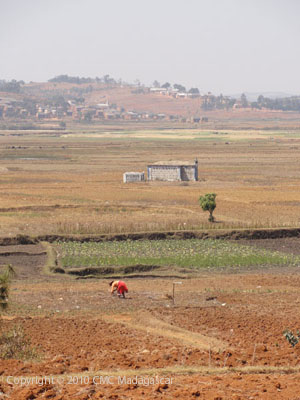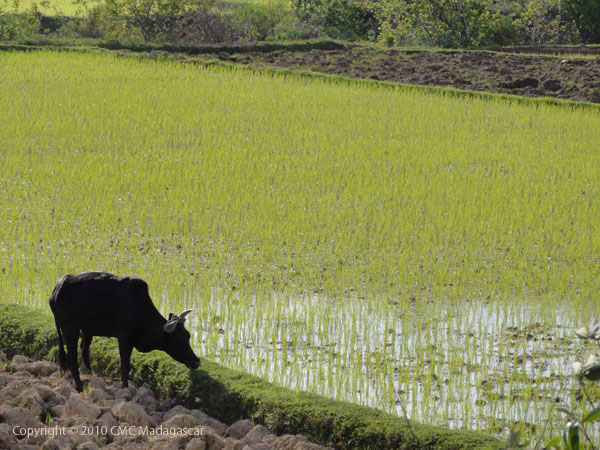












Madagascar, the Great Island, is a preserved land that has integrated external influences to create a synthesis that is both diverse and unique.
Throughout the country with its eighteen ethnicities, one finds common cultural characteristics: ancestor worship, fady, kabary, circumcision, rice, zebu sacrifices, the lamba, Hira gasy, and more.
On the Highlands, rural, industrious, and less frequented by tourists, the richness of Malagasy culture is expressed, offering visitors more than just a picturesque view of local customs, but a true discovery of a different way of life, social relationships, and life events.
Finally, the distinctive music gives life meaning. The highly developed craftsmanship on the plateaus allows artistic expression through repeatedly practiced techniques.
Chapter index:
 |
| The Ancestors |
Attentive visitors will quickly realize that Malagasy people pay very special attention to their ancestors. Even in daily gestures, the reference to those who came before them is constant. They think of them, ask for their advice, or seek their protection.
"Madagascar is often called the Island of Ancestors because of the considerable influence of the dead on the living. The Malagasy dare not undertake anything without the agreement of the elders and without asking for the blessing of their ancestors. An individual is only recognized in society by the name and group of his ancestors, called razana. These ancestors are part of daily life, although they remain invisible."
Museum of Art and Archaeology of Madagascar (website)
A series of personal, family, or more widely shared rituals punctuates life in permanent relation with the afterlife. It is not uncommon, for example, to pour a drop on the ground when opening a new bottle to "give the ancestors something to drink."
One of the most fascinating manifestations is the Famadihana, more commonly known as the "turning of the dead" festival. During the austral winter, descendants of "zana drazana" organize a grand and festive gathering that lasts for three days, during which they exhume the bodies from the family tomb to change the shrouds. This ceremony takes on a particularly strong popular and symbolic character in Vakinankaratra.
The daily life of Malagasy people is governed by "fady," a kind of taboo. Thus, when a place, for example, is fady, certain rules must be respected: do not throw anything away, do not pick anything up, do not swim (for lakes, etc.) these rules are specific to each place and are often legitimized by ancestral history.
Days can be fady, especially for funerals or the construction of a house. The prohibition can also concern food such as pork, goat, crab,... it is passed down from generation to generation by the father or mother.
If the prohibition is violated, the perpetrator commits a fault against the ancestors and exposes themselves to risks that can go as far as losing their life. It is said that a Chinese man drowned in Lake Titriva. However, there are two fady: not to transport pork, not to swim!
For visitors, fady places are sometimes recognizable by a white cloth hung on a tree or another distinctive marker, but the inhabitants are vigilant. For more precision, there is a fady guardian, responsible for its interpretation and application, often the village chief (or family) or an elder.
Fady can also be very constraining, like the fady concerning twins in the Antemoro populations, or the one concerning the relationship between the Antemoro and the Antevolo, which has been the subject of several unsuccessful attempts by the state to end it.
See also: " Fady in Madagascar "
Kabary, traditional speeches, occupy a special place in Malagasy social life. There is no important event (wedding, funeral, turning of the dead, political meetings...) that is not preceded by one or more kabary, true oratorical jousts between different speakers. The most important ones are those pronounced by monarchs and those for marriage proposals, which can last for hours. Kabary existed before the arrival of writing in Madagascar, hence the importance of lovantsofina (oral tradition) in its transmission.
It is used to explain, to persuade, and to condense ideas. To allow for memorization, the mpikabary (speaker) uses expressions or quotations that do not blend with common language but are still accessible enough. The quality of a speech is judged by the relevance and quantity of the expressions chosen by the speaker, and it is generally during the ritual of purification, the fialan-tsiny, that they must demonstrate their skill. They must be both cheerful, ironic, and full of humor to win the audience's approval.
These verbal expressions are generally proverbs, adages, sayings. Since the Malagasy do not make a distinction, all these expressions fall into the category of ohabolana or proverbs. Some experienced speakers sometimes use hain-teny (science of speech, art of poetic dialogue) in marriage proposal kabary. The quintessential art of eloquence, its practice was until now reserved for men. Today, more and more women and young people are passionate about kabary...
Excerpt from the book "Madagascar Fenêtres" (Ed Cite Ambatonakanga)
Circumcision is a ritual that allows a child to transition from the world of women to the world of men. It involves performing an operation to remove the foreskin. This ceremony is increasingly performed with the help of a doctor, but traditionally warriors were sent to fetch sacred water used by a "surgeon" to clean the wound. It can be individual or collective.
Sambatra (group circumcision) is a ritual ceremony celebrated in winter, from July to September according to tradition, but also for reasons of hygiene. It remains an important festival in rural areas, especially in the Southeast, where it is celebrated for a month every seven years.
All uncircumcised children, during the last seven years, are gathered and brought to the "Rain-jaza" (traditional healer). On the first Friday of the full moon. Assisted by family and friends, parents begin to build the "lapa" (hut prepared for the occasion).
For several days, traditional songs are sung and the population engages in frenzied dances accompanied by instruments such as the accordion, the "valiha," and drums. Games and sports competitions are organized.
On the "D" day, early in the morning, at the first crow of the rooster, young men "velondray aman-dreny" (non-orphaned of father and mother) will go to fetch the "rano mahery" (sacred water) from the sacred source. On their return, simulated attacks are made to prevent them from bringing the sacred water back to the lapa. If, unfortunately, the container falls, they will be obliged to return to the source. They must then show cunning to accomplish their mission. The sacred water is welcomed to the lapa by the families who proclaim in unison "Zanaboromahery, manatody vato."
Then the Rain-jaza begins his circumcision work following a ritual scrupulously. The chants and cries of the women mask the cries and moans of the circumcised children. After circumcision, fathers or grandfathers swallow the foreskins of their circumcised children wrapped in a banana or egg white.
The ceremony always ends with a grand feast accompanied by strong drinks.
Source: Website of the Embassy of Madagascar in Senegal (website)
Rice is an institution in Madagascar. In some regions, it is consumed at all three daily meals. One cannot imagine a meal without rice.
The menu consists of rice accompanied by a "soup." Malagasy dishes (romazava, ravitoto sy henakisoa, etc.) are essentially composed of soups or meat and fish in sauce accompanied by vegetables.
See also: http://www.gasykamanja.com/recette/liste_plats.html.
See also: Rice Culture in the Highlands of Madagascar
The zebu holds a predominant place in Malagasy life and culture.
 |
| The Zebu |
Its tender and flavorful meat is particularly appreciated; but its role does not stop there. It is also used for transportation, plowing, and trampling rice fields.
Its importance is such that it has become mythical for Malagasy people. All the major events of life are celebrated with a "zebu sacrifice" and a meal shared with numerous guests. Failing to comply with this tradition can lead to misfortunes for families and their ancestors. Thus, it is not uncommon to be condemned to sacrifice a zebu to redeem a fault.
The sacred ritual of zebu sacrifice is accompanied by songs and dances under the authority of an elder, guardian of traditions and codes specific to the event.
As for certain sacred places (fady), the lamba (traditional attire) is mandatory for anyone officiating or present within a delimited perimeter around the place of sacrifice.
Finally, the zebu is a sign of wealth and social status. The more zebus are sacrificed during a marriage, funeral, circumcision, or building construction, the more one affirms their rank in society.
The Lamba is more than a traditional costume for Malagasy people. It is worn by both women and men and accompanies them throughout their lives as clothing, as a blanket at night. It is present at all festivals and ceremonies until the day of their death when it will serve as a shroud.
A sign of dignity, it is mandatory in certain places and circumstances. It can also be a sign of love when the engaged couples exchange them as a sign of union. The assembly then vows happiness to the future spouses "for life."
Consisting of a fabric of two meters fifty by one meter, there are several types: - the lamba arindrano: ceremonial garment of nobles, the wealthy, or the elderly. - the lamba mena: richly embroidered, it is intended to wrap the dead. - the lambahoany: printed cotton pareo that women from coastal regions tie under their armpits and men around their waist. - the lamba telo soratra: with three different colored bands. - the jabo-landy: made of silk mixed with raffia. - the arindrano landihazo: made of silk mixed with cotton. - the salaka: silk loincloth passed around the waist and between the legs.
This costume is abandoned in large cities where people prefer Western clothing. It remains in use for festivals and ceremonies for its elegance and sacred character.
The Hira Gasy is considered the ancestor of modern theater. It is a popular spectacle practiced in the countryside of the highlands during the slow periods of agricultural activity.
Often very lively, they are an integral part of the life of the populations.
The Fitampoha is a religious ceremony on the west coast of Madagascar. It consists of a sacred celebration called the "Bath of Relics," during which the relics of ancient kings of the region are bathed in the Tsiribihina River. It takes place in Belo sur Tsiribihina every ten years, in years ending with 8: 2008, 2018, ...
Also see: